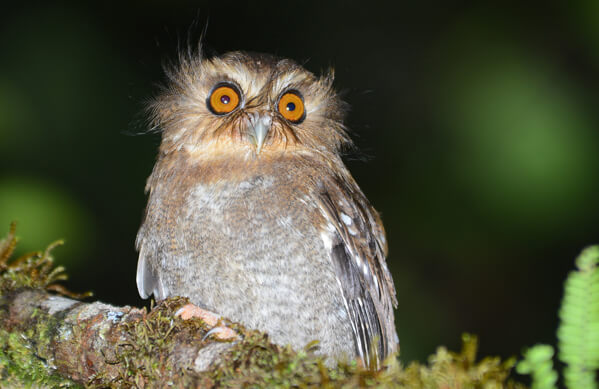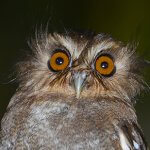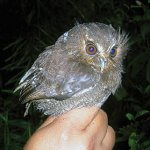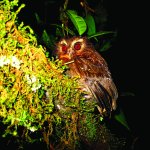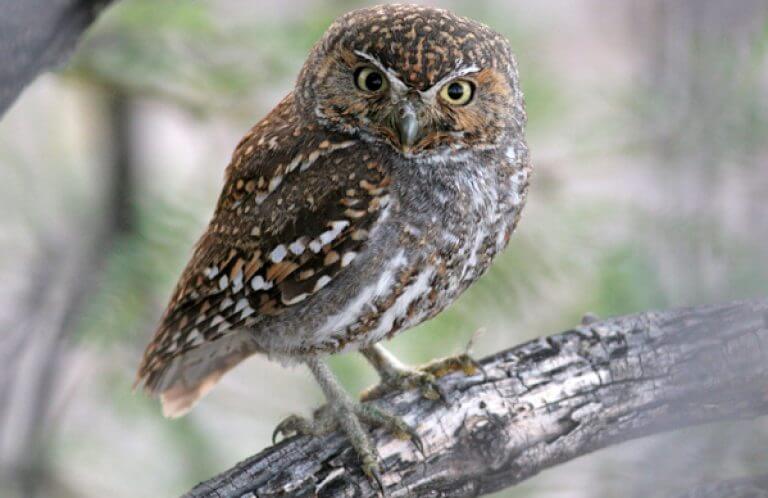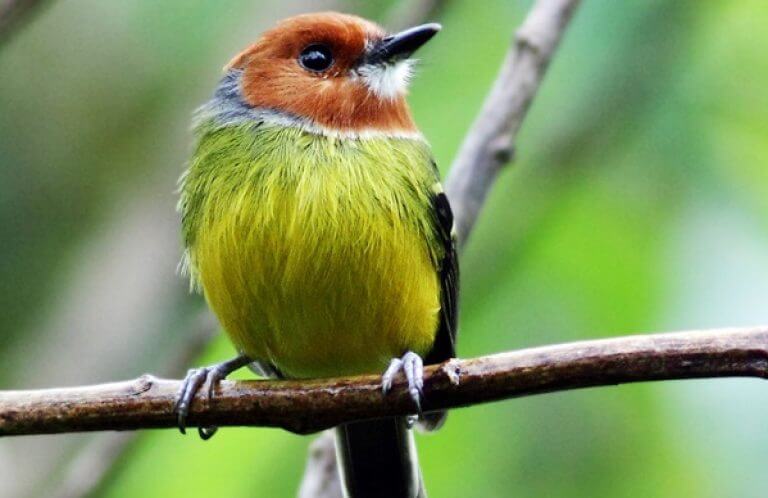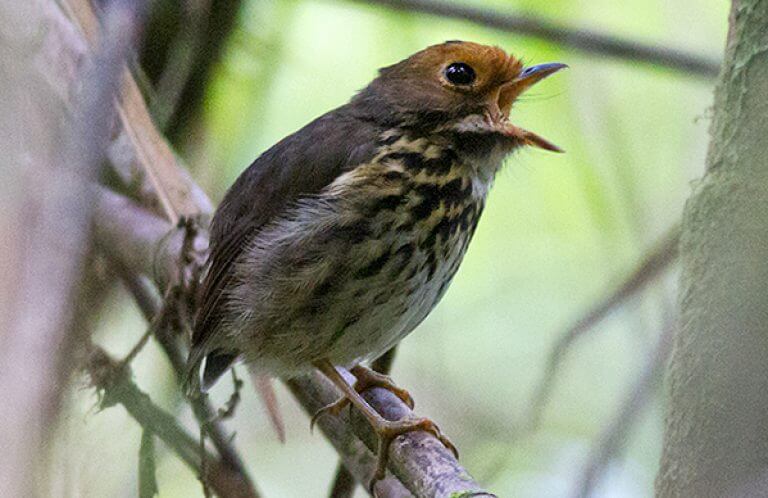About
At only five inches long, the Long-whiskered Owlet is one of the smallest owls in the world, along with the Elf Owl of North America and Mexico. First discovered in 1976, the Long-whiskered Owlet is so distinctive that scientists placed it in its own genus, Xenoglaux, which means “strange owl” in Greek. One of this owlet's most distinctive features is long, wispy facial feathers that extend out past its head, resembling ear tufts. However, it lacks the true ear tufts of an Eastern Screech-Owl or Great Horned Owl.
The Long-whiskered Owlet is also notable for its reddish-orange eyes topped by conspicuous light "eyebrows," bare legs and feet, and short, stubby wings and tail. It had been suggested that this owlet was almost flightless, but more recent surveys noted individuals in flight.
Lost and Found
After its initial discovery, the Long-whiskered Owlet disappeared once more and was not re-sighted until 2002. This extreme elusiveness can partially be explained by its inaccessible habitat: cloud forest in the Andean mountains of northern Peru, on steep slopes with dense, dripping-wet undergrowth. The understory — choked with thick blankets of mosses, tangles of vines and epiphytes, thickets of Chusquea bamboo, and towering tree ferns — poses another obstacle to those who want to observe this tiny owl.
The 2002 rediscovery occurred in habitat that now comprises the Alto Mayo Protection Forest. The species was re-found again at Abra Patricia in 2007, where ABC and partner Asociación Ecosistemas Andinos (ECOAN) protect nearly 25,000 acres for the owlet and other rare birds, including the Ochre-fronted Antpitta, Johnson's Tody-Flycatcher, and Royal Sunangel.
Songs and Sounds
Like most owls, this species is more often heard than seen. The Long-whiskered Owlet's call is a single, abrupt, husky-sounding "woh," repeated every few seconds. It may also give a rapid, low-pitched trill, which is rarely heard.
Breeding and Feeding
Insect-eating Owlet
Although its courtship, breeding, and nesting behaviors are still undescribed, scientists theorize that they are similar to that of other small owls such as the Ferruginous Pygmy-Owl and Boreal Owl: monogamous with long-term pair-bonds, reinforced by courtship feeding by male to female and mutual preening. Like these owls, the Long-whiskered Owlet probably nests in tree holes or other natural cavities, with both parents feeding and tending the young.
Like other small owls, such as the Flammulated Owl, the Long-whiskered Owlet feeds primarily on insects, but it may eat small frogs or lizards as well.
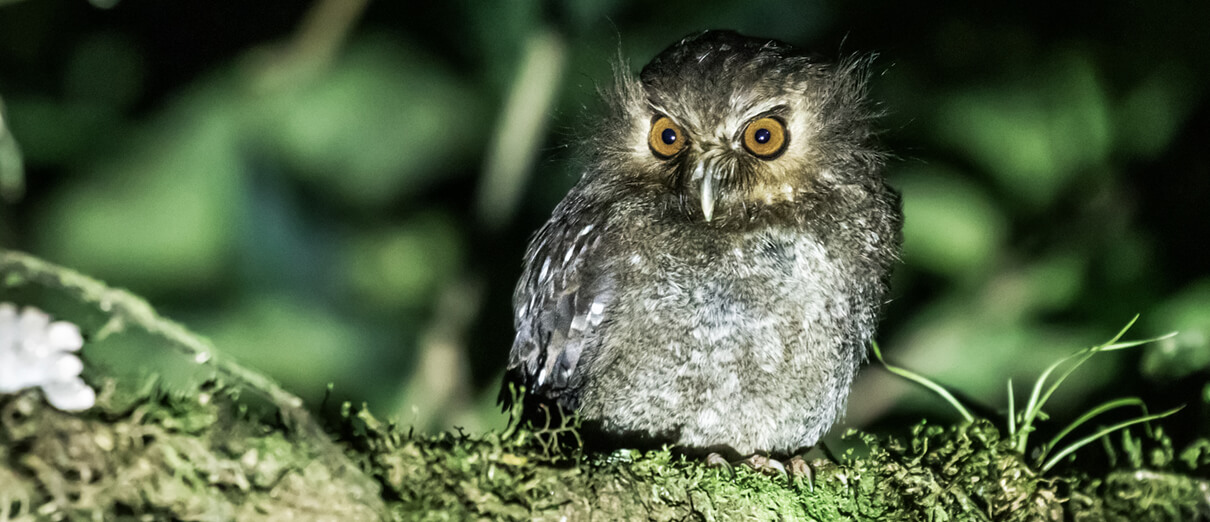
Region and Range

Restricted-range Resident
This little owl is only known from a few spots in the cloud forests wreathing the eastern slope of the Andes in northern Peru, where it is a permanent resident.
Conservation
Since it has a tiny range, the Long-whiskered Owlet is especially sensitive to ongoing habitat loss caused by expansion of agriculture, mining, timber harvesting, and human habitation in the Andes of northern Peru.
Reforesting for the Birds
Supported by ABC, reforestation is ongoing at Abra Patricia and surrounding areas, where over 1.2 million native trees and shrubs have been planted along with more than 250,000 shade-coffee plants on private lands. These plants are all grown at community nurseries by and for local people.
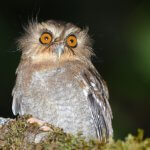
Help support ABC's conservation mission!
ABC and ECOAN are also working with surrounding communities to establish additional Protected Conservation Areas (PCAs), including the enormous Monte Puyo PCA, which protects almost 40,000 acres of Peruvian cloud forest, including more habitat for the Long-whiskered Owlet.
Get Involved
Many of the rarest bird species in the Western Hemisphere remain relatively unknown. You can learn more about these birds and the threats they face by signing up for ABC's Bird of the Week email series, which frequently highlights these fascinating birds.
American Bird Conservancy and our partners throughout Latin America and the Caribbean have created and expanded more than 100 bird reserves, which protect upward of 1.1 million acres of vital habitat. Together, we've planted more than 6.8 million trees, helping to restore degraded and damaged habitat. You can help us continue to protect endangered birds by making a gift today.





































